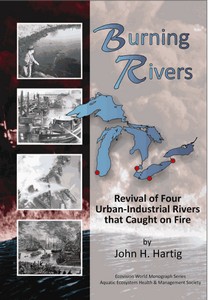
Great rivers can, and literally have, caught fire. This week Dr. John Hartig, refuge manager of the Detroit River International Wildlife Refuge and author of
Burning Rivers, explains this phenomenon and writes about those unwilling to let the heritage and wildlife of the Detroit and Rouge River ecosystems go out in flames.
Post 3: Burning Rivers
Posted By: John Hartig
Posted: 4/9/2011
 How many rivers in the Great Lakes basin ecosystem have literally caught on fire and burned? Would you be surprised to know that there have been four burning rivers? You may have heard of the burning of the infamous Cuyahoga River in Cleveland, Ohio. However, we also have one in our backyard – the Rouge River. The other two are the Buffalo River in New York and the Chicago River in Illinois.
How many rivers in the Great Lakes basin ecosystem have literally caught on fire and burned? Would you be surprised to know that there have been four burning rivers? You may have heard of the burning of the infamous Cuyahoga River in Cleveland, Ohio. However, we also have one in our backyard – the Rouge River. The other two are the Buffalo River in New York and the Chicago River in Illinois.
These four rivers caught on fire because of gross oil pollution caused by society's indiscriminate use and abuse of these aquatic ecosystems. Today, however, each of these rivers is experiencing dramatic environmental improvement and some surprising ecological revival.
The revival stories of these burning rivers are fascinating. In the case of the Rouge River, concerned citizens in Dearborn and Melvindale began to speak out in 1983 about the smell of rotten eggs emanating from the Rouge River. Nearly 1,000 signatures were gathered in petitions in 1984, protesting the raw sewage being discharged to the river that was causing the odor problems, and then delivered to state and federal officials. Then in 1985 a 23-year old man fell into the Rouge River, swallowed water, and died of leptospirosis or rat fever. Although health department officials stated publicly that this man's death could not be traced to water pollution in the Rouge River, most people knew that the probable cause was raw sewage discharge. Governments had no choice but to respond with a comprehensive approach to controlling and managing water pollution.
In 1985, the Rouge River Basin Committee was established, involving all 48 watershed communities in solving this public health problem. In 1986, Friends of the Rouge was established and the first Rouge Rescue held.The institutional framework for watershed cleanup and prevention evolved from the Rouge River Basin Committee, to the Rouge River Remedial Action Plan Advisory Council, to the Rouge River National Wet Weather Demonstration Project, and, most recently, to the Alliance of Rouge Communities. Today, the Rouge River is a model of watershed management by virtue of having the first watershed-based storm water permit in the nation.
This year marks the 25th anniversary of Friends of the Rouge and I can think of no better to celebrate the accomplishments then to look back and see how far we have come and remind people of what remains to be done to care for this river as our home.
To help teach the lessons of the past and to help convince people of the urgent need to address the remaining challenges, I have written a new book titled Burning Rivers: Revival of Four Urban-Industrial Rivers that Caught on Fire. Burning Rivers tells these unique environmental histories, translates the science, provides practical lessons learned in river restoration, and will inspire people to be good stewards of rivers. This story of burning rivers/river revival also gives hope. If these four river systems can be revived and made into community assets, there is hope for all rivers and all people and organizations working to restore their river ecosystems.
Everyone interested in the environment, quality of life, conservation, and sustainability will learn something from this book. If interested in the story of burning rivers, books are available from Michigan Sea Grant, Amazon, Multi-Science, and the Aquatic Ecosystem Health & Management Society (AEHMS).
Book proceeds go to the Aquatic Ecosystem Health and Management Society.
Burning Rivers cover image courtesy of John Hartig